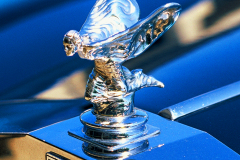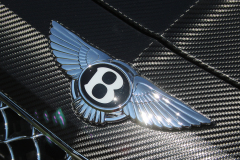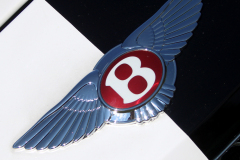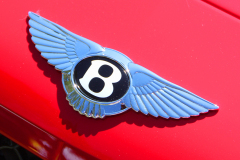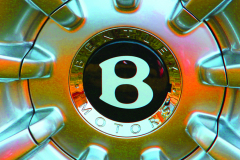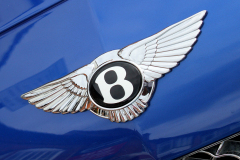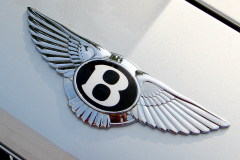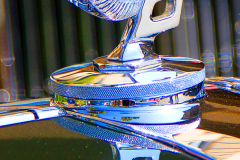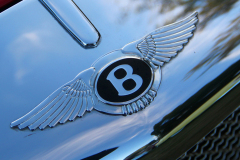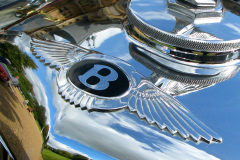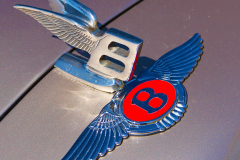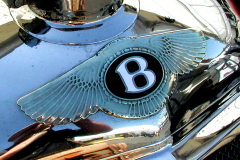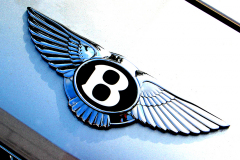Bentley | Rolls Royce
Bentley Motors Limited, a British luxury automaker, and smaller rival to Rolls-Royce, was founded by W. O. Bentley in 1919. Bentley cars were largely hand-built and had a reputation for high performance and durability.
Bentley became widely known for winning the 24 Hours of Le Mans race in 1924, 1927, 1928, 1929 and 1930.
Prominent models from that era were the historic sports-racing Bentley 4½ Liter (vehicle of choice of James Bond in the original novels, seen only briefly in the films), the Bentley 6½ Litre and the high-performance Bentley Speed. The Bentley Speed Six, introduced in 1928 as a more sporting version of the 6½ Litre, would become the most successful racing Bentley.
The Bentley Flying B mascot has been used since 1920. Bentley initially built aircraft engines so they naturally used stylized wings as part of their symbol.
The Bentley 8 Litre (1930-1932), was a luxury car based on the largest rolling chassis made and the last completely new model before the company’s financial collapse.
Although a group of wealthy British motorists known as the “Bentley Boys” kept the marque’s reputation alive, the company failed to weather the onset of the Great Depression and was acquired by Rolls-Royce in 1931.
When the new Bentley 3½ Litre appeared in 1933, it was a sporting variant of the Rolls-Royce 20/25. Rolls-Royce’s advertisements for the Bentley 3 1⁄2 Litre called it “the silent sports car”, a slogan Rolls-Royce continued to use for Bentley cars until the 1950s.
All Bentleys produced from 1931 to 2004 used Rolls-Royce chassis and adapted Rolls-Royce engines, described by critics as badge-engineered Rolls-Royces.
At that time Bentley and Rolls-Royce did not supply complete cars – they sold rolling chassis, near-complete from the instrument panel forward. Each chassis was delivered to the coach builder of the buyer’s choice. The first full steel-bodied model produced was the Bentley Mark VI (1946-1952), four-door, full-size luxury saloon, also available as a chassis only. Chassis remained available to coachbuilders until the end of production of the Bentley S3 in 1965.
Rolls-Royce established in 1904 by the partnership of Charles Rolls and Henry Royce, is a renowned luxury car manufacturer with a reputation for superior engineering quality.
The Rolls-Royce Silver Ghost, (1906-1926) originally named the 40/50 h.p. was a car of legendary smoothness that completed a 14,371 mile run virtually non-stop, creating the “best car in the world” legend.
The Rolls-Royce Twenty (1922-1929) was Rolls-Royce’s “small car” for the 1920s and was produced alongside the 40/50 Silver Ghost and its successor the Rolls-Royce Phantom. It was intended to appeal to owner-drivers but many were sold to customers with chauffeurs.
From soon after World War II until 2002, standard Bentley and Rolls-Royce cars were often identical apart from the radiator grille and minor details.
The Silver Wraith (1946-1958) was the first post-war Rolls-Royce. It was only available as a chassis whereas the shorter Bentley Mark VI (was also available with a full steel-body.
Rolls-Royce manufactured the high-powered “R” engines responsible for land and air speed records as well as successful performances in automobile racing.
Also known as the Silver Wraith II, the Silver Shadow (1965-1980) was produced in various forms. The Silver Shadow was the first Rolls-Royce to use a monocoque chassis and still holds the record for the largest production volume of any Rolls-Royce.
The Rolls-Royce Corniche (1971-1995) was a two-door, front-engine, rear wheel drive five-seater coupé and convertible. Named for an Italian term for a coastal road, especially along the face of a cliff, most notably the Grande Corniche along the French Riviera above the principality of Monaco. The Bentley Continental version of the Corniche was also sold in 1984.
The Rolls-Royce Phantom series started in 1925 as a replacement for the Silver Ghost and has been in production through 5 iterations until 1990, only interrupted during World War II. The Rolls-Royce Phantom VII was a full-sized luxury saloon launched in 2003. It was the first Rolls-Royce developed and introduced after BMW purchased the right to use the Rolls-Royce name and logo in 1998.
Other memorable models include the Rolls-Royce Silver Dawn (1949-1955)(1994-1998), Rolls-Royce Silver Cloud (1955-1966) and Rolls-Royce Silver Spirit/Spur (1980-1999), and Rolls-Royce Flying Spur (1994-1995).
The Rolls-Royce mascot “The Spirit of Ecstasy”, also called “Emily”, “Silver Lady” or “Flying Lady”, was designed by English sculptor Charles Robinson Sykes in 1911. Sykes called it “A graceful little goddess… who has selected road travel as her supreme delight…”. An alternate kneeling version was also designed by Sykes in 1934 to suit the needs of the new sports saloons by providing their drivers with a clearer view of the road ahead. This was ultimately abandoned in favor of a smaller version of the original standing mascot, and so it remains to this day.
A marketing survey in 1987 showed that only Coca-Cola was a more widely known brand than Rolls-Royce.

